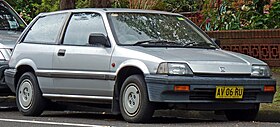| Honda Civic Third generation | |
|---|---|
 | |
| Overview | |
| Manufacturer | Honda |
| Model code |
|
| Production | September 1983 – September 1987 |
| Model years | 1984–1987 |
| Assembly |
|
| Designer | Yoshio Ui, Tsuyoshi Nishimura, Osamu Akimoto (1981)[2] |
| Body and chassis | |
| Class | Subcompact car |
| Body style | 3-door hatchback/kammback (AG-AH/AT) 3-door coupé (AE-AF; CRX) 4-door sedan (AJ-AK/AU) 5-door station wagon (AJ-AK/AR; Shuttle) |
| Layout | Front-engine, front-wheel-drive / four-wheel-drive |
| Related | Rover 200 Honda CR-X Honda Ballade Honda Quint Honda/Acura Integra |
| Powertrain | |
| Engine | |
| Transmission | 4/5-speed manual 5+1 speed manual 4WD 3-speed Hondamatic semi-automatic 4-speed Hondamatic semi-automatic |
| Dimensions | |
| Wheelbase | 93.7 in (2,380 mm) (hatchback) 96.5 in (2,451 mm) (sedan) |
| Length | 150 in (3,810 mm) (hatchback) 164 in (4,166 mm) (sedan) |
| Width | 64 in (1,626 mm) |
| Height | 53 in (1,346 mm) (hatchback) 55 in (1,397 mm) (sedan) |
| Chronology | |
| Predecessor | Honda Civic (second generation) Honda L700 (for Shuttle) |
| Successor | Honda Civic (fourth generation) |
The third-generation Honda Civic is an automobile which was produced by Honda from 1983 until 1987. It was introduced in September 1983 for the 1984 model year. The Civic's wheelbase was increased by 2–5 inches (5.1–12.7 cm) to 93.7 inches (238 cm) for the hatchback or 96.5 inches (245 cm) for the sedan. A three-door hatchback/kammback, four-door sedan (also known as the Honda Ballade), the five-door "Shuttle" station wagon, and sporting CRX coupé shared common underpinnings. This included MacPherson strut suspension with torsion bars in the front and a rear beam with coil springs. However, the body panels were largely different between models. The Civic-based Honda Quint five-door hatchback also underwent a model change, and became the Honda Quint Integra, available as both a three- and five-door fastback. The Quint Integra (soon just "Integra") was sold at the Japanese Honda Verno dealership along with the CR-X. The Civic in Japan was now exclusive to Honda Primo, along with Honda's kei cars as well as superminis like the Honda City.
At its introduction in 1983, it won the Car of the Year Japan Award.
- ^ Leeps (4 June 1989). "Rust Busters". New Straits Times / Google News Archive. Retrieved 3 May 2015.
- ^ "Automobile".